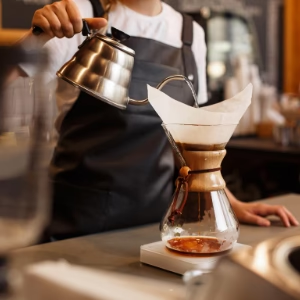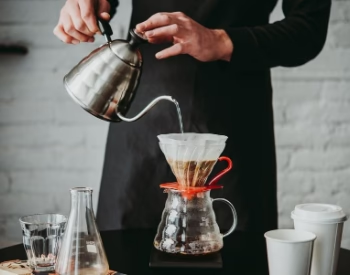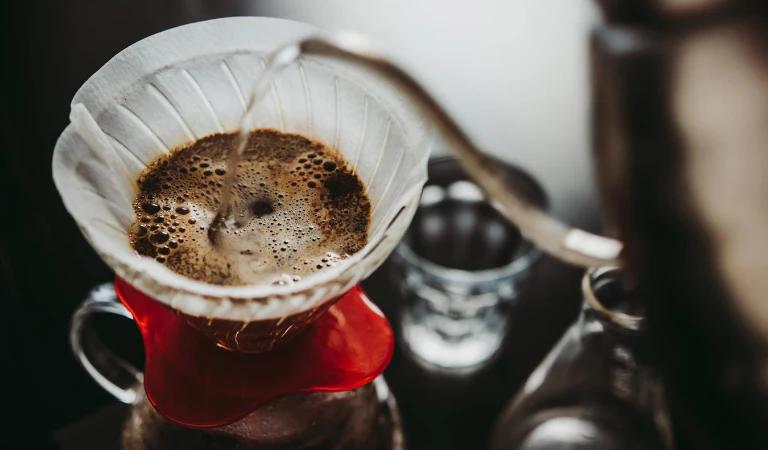Nothing beats a perfectly brewed cup of coffee. Whether it's the start of your customer’s day or their afternoon pick-me-up, a steamy cup of coffee from your cafe is something everyone looks forward to. As a business owner, you might be searching for ways to improve the coffee-making process at your restaurant. Pour over coffee is a popular method of serving coffee and well-loved amongst baristas and coffee drinkers.
In terms of your business, brewing pour over coffee at your cafe, bakery, or restaurant has a multitude of benefits. Pour over coffee is known to be a better cup of coffee than other styles of brewing and provides a unique experience for customers. Below is everything you need to know about pour over coffee and why you should consider brewing it at your establishment.
How To Make Pour Over Coffee
Pour over coffee is made by pouring hot water by hand through coffee grinds which are then filtered into a carafe or cup. Although the process might be a bit slower than traditional brewing methods, like drip coffee, the results are an unbeatable cup of coffee. Pour over coffee is loved by baristas because of the control it gives them when making coffee and the quality of coffee it produces. To properly make pour over coffee at your establishment, each component of the brewing process must be done correctly to make the perfect cup of joe.
Best Kinds of Coffee Blends
The best kind of coffee beans for making pour over coffee really depends on the preference of your customers. The pour over method brings out the delicate flavors of each roast, so your cafe should have a variety of blends that range from light roast to dark roast. Choose coffee beans that are known for their unique tastes or blends that are fan favorites amongst your customers. Pour over coffee is perfect for showcasing the bitterness and different flavors of your coffee beans.
In order to make pour over coffee, it is important to make sure that the coffee beans are expertly ground. Pour over coffee is adaptable to your coffee blend, so it benefits from both coarsely-grounded beans or finely-grounded beans. Generally, a medium grind works best for the pour over coffee method. Depending on your customers’ preferences, you can find a grind size that works best for your establishment. If your guests tend to purchase sweeter coffees, go for a finely-ground coffee blend. However, if your customers enjoy bitter-tasting coffee, a coarsely-ground blend works best.
Water Temperature
As always, using hot filtered water to produce a steamy cup of coffee is preferred. For pour over style brewing, getting your water at the perfect temperature is crucial. A rule of thumb to follow is that your water should be heated between 190°F to 205°F. This way the heat from the water seamlessly integrates with the coffee grinds to make a great cup of coffee.
Another critical part of the pour over brewing process is finding the ideal ratio between coffee and water. No one enjoys a watery brew or a weakened coffee, so you must use the exact amount of water needed to produce a good cup. A ratio to follow for pour over coffee would be 17 grams of water for 1 gram of coffee, but it can vary depending on how finely your coffee has been ground.
Filters
Using a filter is key in most coffee-making methods. For pour over coffee, you can either use a disposable or reusable filter, depending how often you are making pour over coffee. Disposable filters are great since they are usually made out of paper that can trap excess oils to produce coffee that isn’t overly bitter. A reusable filter is traditionally made with stainless steel or an eco-friendly material and has a mesh screen. Reusable filters are ideal for frequent use at busy establishments to help reduce waste and lower costs. The finer the mesh is in the filter the more of a rich, full-bodied flavor your brew will produce.
Pouring
The most unique aspect of pour over coffee is the ability to pour out coffee by hand instead of allowing a machine to do it. Although there is not a wrong way to go about this step, to make the best pour over coffee possible you must find a pouring technique that works for you. The key is to pour water into the filter in an even and consistent manner. Many baristas prefer to pour in a circular motion for better control and to ensure an even pour.
Alternatively, to eliminate any channeling or grounds sticking to the sides of the filter, some baristas use the pulse pouring method. Pulse pouring is done by pouring the same amount of water into the filter and briefly pausing between each pour. If you find that your coffee grounds start to channel in the filter, then try this method to prevent any channeling or disruption in the filter. Regardless of the method used, you can easily brew a great batch of coffee, as long as the water is poured evenly.
Essentials For Pour Over Coffee
To narrow down the list of supplies for your pour over coffee method, here’s what you need to make the best cup of pour over coffee:
- Your preferred coffee blend: We recommend going for a rich, strong dark roast to fully enjoy all the flavors of your coffee the pour over method can bring out.
- Hot water: For best results, heat your water in a kettle around 190°F to 205°F.
- Gooseneck kettles: To control the flow rate of your hot water, using a gooseneck kettle provides a secure grip and an even, accurate pour.
- Your filter of choice: Although the pour over coffee method is flexible for all kinds of coffee filters, using a reusable filter with fine meshing produces the best batch of coffee.
-
A cup or a carafe: When pouring steamy water through your kettle and into your
filter, reach for a container that can hold your coffee without creating messes or splashes.

The Difference Between Pour Over And Drip Coffee
Pour over coffee requires you to pour water into a filter to produce a cup of coffee. Drip coffee involves the use of an electric coffee maker than pours and filters coffee on its own. While no two methods of coffee brewing are created equal, each has its own benefits and disadvantages.
Pour Over Coffee
Pour over coffee is well-liked because it offers the control and quality that drip methods take away. For baristas, it adds an interactive part to their process. The slower water is poured, the more flavor is pulled from the grounds. For customers seeking a rich, expertly brewed cup of coffee, pour over coffee is worth the wait.
Drip Coffee
Drip coffee has the benefit of making a cup faster than the pour over method. Drip coffee machines have largely replaced any other method of coffee making, for both businesses and consumers at home. These coffee machines are efficient and some can even allow you to set a timer to produce a cup of joe. Drip coffee requires little work at the end of your barista. However, drip coffee tends to produce watered down coffee.
Why Pour Over Coffee Works For Your Business
Pour over coffee is a great addition to the brewing methods at your coffee shop, bakery, or restaurant. For coffee lovers, the benefits pour over coffee brings to their favorite drink are highly appealing. The kind of quality and flavor pour over coffee produces is hard to find. For a richer, fuller roast many customers won’t mind paying the extra price or waiting a bit longer than usual. By offering pour over style coffee at your cafe, you can bring in an entirely new crowd of customers while still satisfying your regulars. Pour over coffee is a unique method that isn’t found in most coffee shops, and can set your business apart from the competition.









